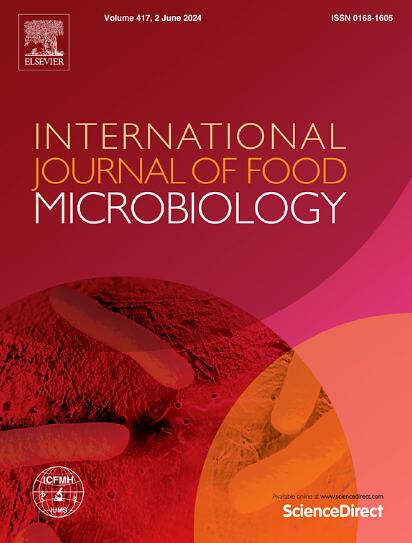Transfer of deoxynivalenol and fumonisins B1 and B2 from maize flour to maize/wheat-based bread
IF 5
1区 农林科学
Q1 FOOD SCIENCE & TECHNOLOGY
International journal of food microbiology
Pub Date : 2025-02-03
DOI:10.1016/j.ijfoodmicro.2025.111092
引用次数: 0
Abstract
Deoxynivalenol (DON) and fumonisins B-type (FBs), mycotoxins synthesized by Fusarium spp., cause serious health problems after their intake. These compounds are frequently found in maize and wheat, the most consumed cereals worldwide and main hosts of Fusarium, making them a food safety problem. This work studies the effect of the maize/wheat-based breadmaking process on the concentrations of DON and FBs. Breads were made using contaminated maize flour (40 %) mixed with uncontaminated wheat flour (60 %). Three factors were analyzed: mycotoxin contamination level (DON: 1.20 or 0.8 mg/kg; FBs: 1.28 or 0.61 mg/kg), sourdough use (absence, artisan or commercial) and fermentation time (2 or 12 h). Doughs were baked at 200 °C for 40 min. DON and FBs were determined by HPLC-DAD and HPLC-FLD, respectively. Additionally, sourdough microbiota was identified. The only isolated yeast was Saccharomyces cerevisiae, while lactic acid bacteria showed great variability, being Lactobacillus plantarum the most common. FBs concentration remained stable during fermentation; while for DON, the highest change was observed in the loaves with an initial concentration of 1.20 mg/kg, commercial sourdough use and 12 h fermented, showing a 28 % increase in its concentration. After baking, mycotoxin reduction was observed under all conditions, except in the aforementioned one that still showed a 16 % of DON increase. Results indicate that the reduction of DON during breadmaking may not be enough to ensure food safety from borderline contaminated flour to meet legal limits. However, bread with FBs levels below the maximum limits can be produced, even when using contaminated flour.
求助全文
约1分钟内获得全文
求助全文
来源期刊
CiteScore
10.40
自引率
5.60%
发文量
322
审稿时长
65 days
期刊介绍:
The International Journal of Food Microbiology publishes papers dealing with all aspects of food microbiology. Articles must present information that is novel, has high impact and interest, and is of high scientific quality. They should provide scientific or technological advancement in the specific field of interest of the journal and enhance its strong international reputation. Preliminary or confirmatory results as well as contributions not strictly related to food microbiology will not be considered for publication.

 求助内容:
求助内容: 应助结果提醒方式:
应助结果提醒方式:


